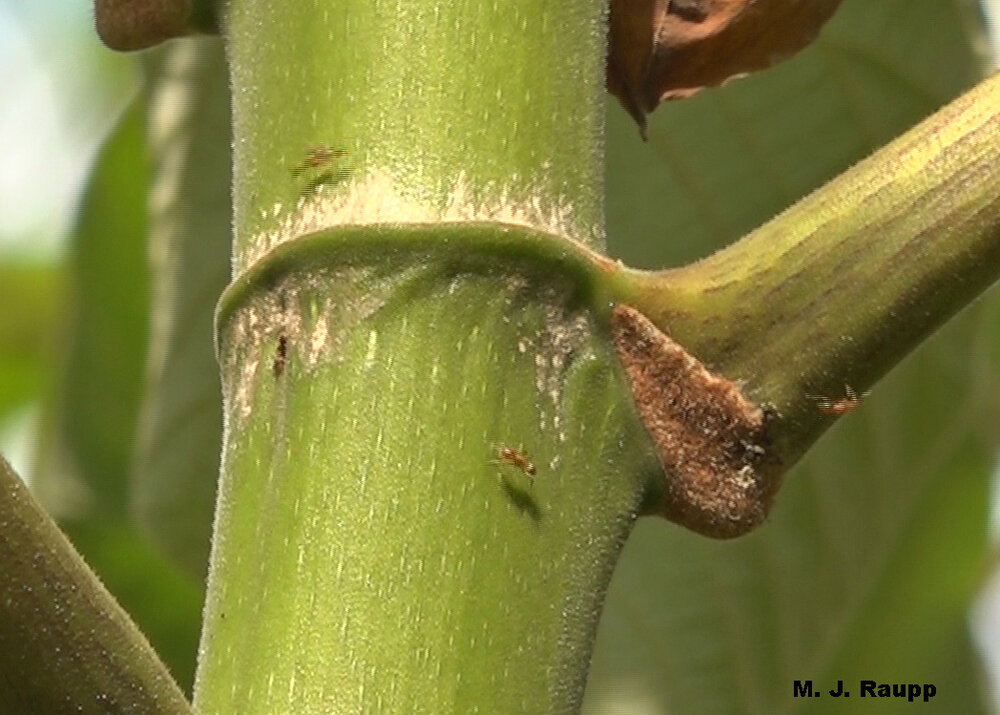Rainforest Ants 4 – The Bodyguards, Part 2: Azteca ants protecting Cecropia trees

In disturbed areas along the edge of the dense tropical forest Cecropia is one of the most common pioneer trees.

At the base of the petiole where leaf joins stem, a brown patch filled with Müllerian bodies provides carbohydrates and other nutrients for Azteca ant bodyguards.
Last week we met fierce Pseudomyrmex ants protecting their tropical myrmecophyte home, the Acacia tree. Myrmecophytes are plants that form a symbiotic relationship with feisty ants which serve as bodyguards. Another group of trees common to tropical forests are Cecropias, a collection of several dozen species many of which are pioneer trees found in disturbed areas along roadways, riverbanks, or light gaps bordering dense tropical forests. Eons ago many species of Cecropia formed partnerships with ants in the genus Azteca. This mutualistic “deal” has two parts. Cecropia trees provide several sources of food including glycogen (a carbohydrate storage molecule), proteins, and lipids in structures called Müllerian bodies, found at the base of a leaf’s petiole, and in Food Bodies scattered on the petioles and blades of young leaves.
Undisturbed, Azteca ants patrol their host at a leisurely pace, but with a shake of a leaf workers swarm from within the stem to defend their colony. I could not resist the chance to assess the potency of Cecropia’s defenders. Compared to last week’s attack by ants guarding Acacia, the sting of Azteca was mild. However, to a caterpillar or beetle attempting to eat leaves of Cecropia, a mass attack by dozens of tiny stinging bodyguards might convince an intruder to seek a meal elsewhere.
Cecropia also satisfies the “gimme shelter” requirement for Azteca ants. The hollow stems of Cecropia are the perfect redoubt to house the queen and raise the brood. And what does Cecropia get from the “deal?” Protection. Clever studies demonstrated that Cecropia devoid of their Azteca bodyguards received more damage from marauding chewing herbivores such as beetles and caterpillars. An additional benefit of ant occupation was the removal of aggressive vines capable of smothering young Cecropia trees. The net effect of ant bodyguards revealed in these studies was more rapid growth in trees protected by tiny but fierce Azteca defenders. For a pioneer species like Cecropia, any advantage you can get on your competitors is an important one and Azteca ant bodyguards may provide just the advantage you need to survive in the wild tropical forest.
On the surface of the trunk, small holes allow Azteca workers to enter an exit the colony. Within the hollow stem, workers tend hundreds of eggs and larvae produced by the queen.
Acknowledgements
We thank Costa Rica Vacations, and the intrepid guides Mono and Kenneth at Rafiki Lodge and Ale and Gera at Playa Cativo Lodge, for providing the inspiration for this episode. The wonderful books “The Insect Societies” by Edward O. Wilson, “The Ants” by Bert Hölldobler and Edward O. Wilson, and the fascinating articles “Azteca protection of Cecropia: ant occupation benefits juvenile trees” by Eugene W. Sehupp and “Food bodies of Cecropia pachystachya (Cecropiaceae) leaves: structural and functional features suggesting complementary role to Müllerian bodies” by Patricia Gonçalves-Souza and Elder Antonio Sousa Paiva, were used as references for this episode.
This post appeared first on Bug of the Week